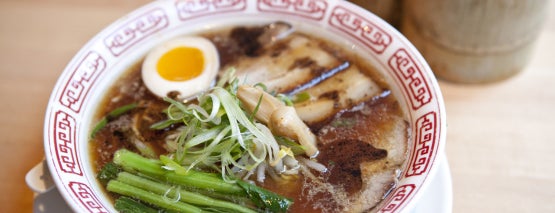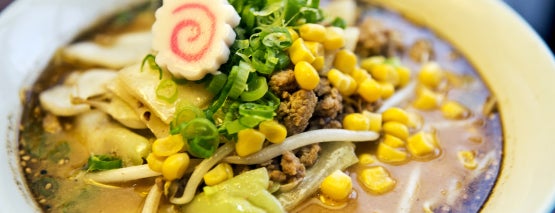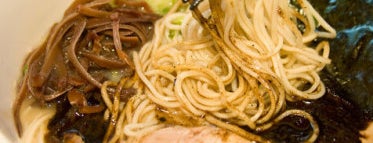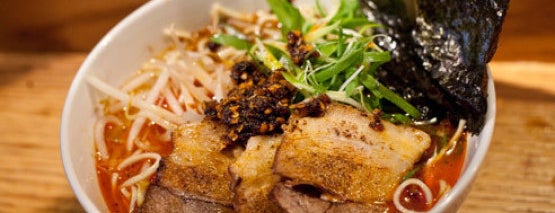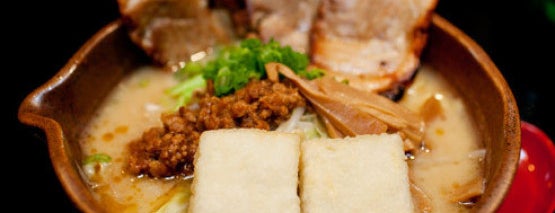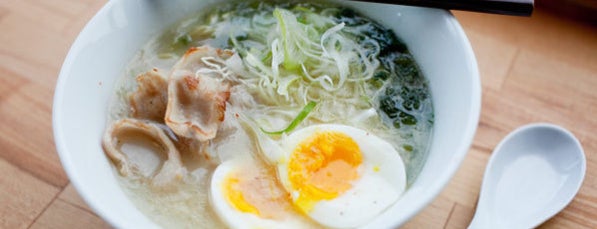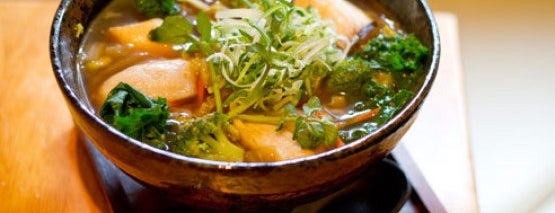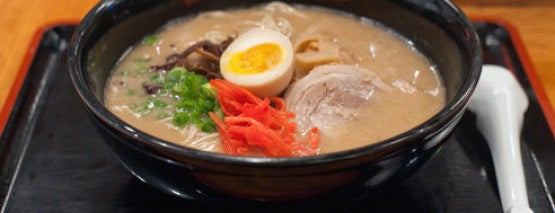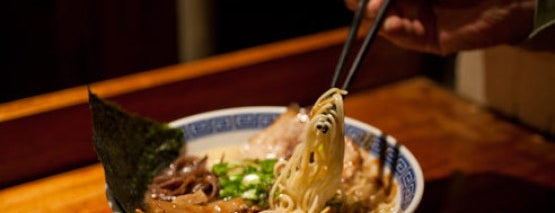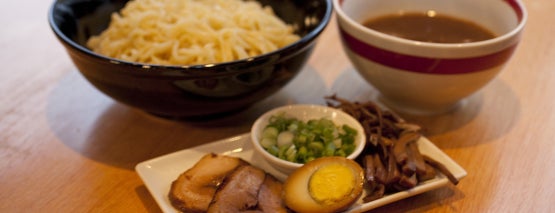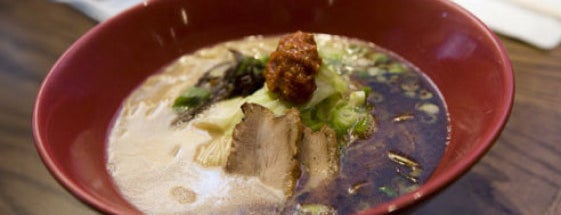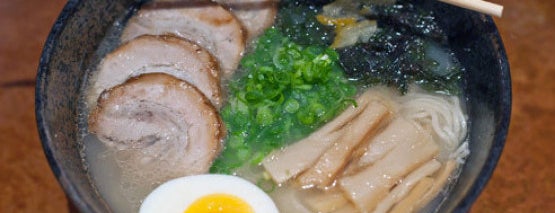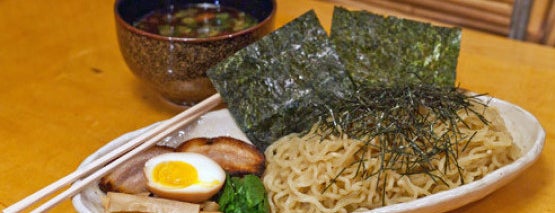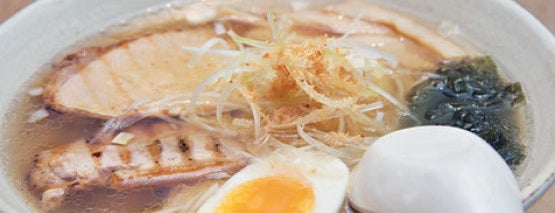![]() Before giving Downtown Brooklyn its own killer ramen den, owner Harris Salat was a food writer, whose culinary crush on Japan was well documented in the The NY Times, Saveur and his own cookbooks. Read more.
Before giving Downtown Brooklyn its own killer ramen den, owner Harris Salat was a food writer, whose culinary crush on Japan was well documented in the The NY Times, Saveur and his own cookbooks. Read more.
![]() In accordance with the restaurant’s name—jin is the kanji character for benevolence—owners Isan Chang and Jenny Ko contribute to charities supporting community-revitalization projects. Read more.
In accordance with the restaurant’s name—jin is the kanji character for benevolence—owners Isan Chang and Jenny Ko contribute to charities supporting community-revitalization projects. Read more.
![]() Hokkaido-born chef Akira Hiratsuka ferments his noodles for 48 hours, which lends the strands a wild, funky character that marries well with the briny shio broth. Read more.
Hokkaido-born chef Akira Hiratsuka ferments his noodles for 48 hours, which lends the strands a wild, funky character that marries well with the briny shio broth. Read more.
![]() The Sapporo-style miso ramen broth boasts more than twenty ingredients, including three types of umami-boosting miso, plus a piquant seven-pepper spice blend. Read more.
The Sapporo-style miso ramen broth boasts more than twenty ingredients, including three types of umami-boosting miso, plus a piquant seven-pepper spice blend. Read more.
![]() Owner Bobby Munekata's mini empire also includes Totto Ramen, Soba Totto and Yakitori Totto. Read more.
Owner Bobby Munekata's mini empire also includes Totto Ramen, Soba Totto and Yakitori Totto. Read more.
![]() Totto's special spicy sauce is not lip-singeing, but the steaming broth coats your mouth and throat in chili, creating a slow burn that builds up as you work your way through the bowl. Read more.
Totto's special spicy sauce is not lip-singeing, but the steaming broth coats your mouth and throat in chili, creating a slow burn that builds up as you work your way through the bowl. Read more.
![]() The Misoya chain, which was founded just outside Tokyo in Chiba, focuses on different regional styles of miso ramen—the shiro variety is typical of Kyoto. Read more.
The Misoya chain, which was founded just outside Tokyo in Chiba, focuses on different regional styles of miso ramen—the shiro variety is typical of Kyoto. Read more.
![]() The three chefs in the kitchen—Jamison Blankenship, James Sato and David Koon— spent months testing different broths, noodles and toppings to create the three bowls on their opening menu. Read more.
The three chefs in the kitchen—Jamison Blankenship, James Sato and David Koon— spent months testing different broths, noodles and toppings to create the three bowls on their opening menu. Read more.
![]() The first issue of Lucky Peach—David Chang's quarterly magazine, published by McSweeney's—includes a travelogue of the chef's ramen-eating adventures in Tokyo. Read more.
The first issue of Lucky Peach—David Chang's quarterly magazine, published by McSweeney's—includes a travelogue of the chef's ramen-eating adventures in Tokyo. Read more.
![]() Souen specializes in macrobiotic, vegan and vegetarian Japanese food; there is a gluten-free option for almost every dish on the menu. Read more.
Souen specializes in macrobiotic, vegan and vegetarian Japanese food; there is a gluten-free option for almost every dish on the menu. Read more.
![]() While tonkotsu is most commonly associated with Japan's Hakata region, Terakawa has its roots in Kumamoto, a nearby prefecture known for its slightly milder variation on the style. Read more.
While tonkotsu is most commonly associated with Japan's Hakata region, Terakawa has its roots in Kumamoto, a nearby prefecture known for its slightly milder variation on the style. Read more.
![]() Kamada fell in love with tonkotsu ramen while living in Tokyo in his twenties, and always wanted to create his own version of the famous pork broth. Read more.
Kamada fell in love with tonkotsu ramen while living in Tokyo in his twenties, and always wanted to create his own version of the famous pork broth. Read more.
![]() Tsukemen is also referred to by the name dipping noodles; rather than being combined in one bowl, the noodles and toppings are served on the side, then dipped with chopsticks into the broth. Read more.
Tsukemen is also referred to by the name dipping noodles; rather than being combined in one bowl, the noodles and toppings are served on the side, then dipped with chopsticks into the broth. Read more.
![]() Ippudo was brought to NYC by Shigemi Kawahara, who is known as "the Ramen King" in Japan; his rich, cloudy tonkotsu broths draw the longest lines the city's ramen-ya, and they're well worth the wait. Read more.
Ippudo was brought to NYC by Shigemi Kawahara, who is known as "the Ramen King" in Japan; his rich, cloudy tonkotsu broths draw the longest lines the city's ramen-ya, and they're well worth the wait. Read more.
![]() This Brooklyn joint is known for its creative, nontraditional ramen styles, including a hot-and-sour variety with shrimp and lemongrass. Read more.
This Brooklyn joint is known for its creative, nontraditional ramen styles, including a hot-and-sour variety with shrimp and lemongrass. Read more.
![]() This no-frills ramen spot—with plenty of seats to spare for a procession of NYU students and Japanese regulars—is a solid backup plan for anyone who doesn't want to wait for a table at nearby Ippudo. Read more.
This no-frills ramen spot—with plenty of seats to spare for a procession of NYU students and Japanese regulars—is a solid backup plan for anyone who doesn't want to wait for a table at nearby Ippudo. Read more.
![]() With 30 seats, Rai Rai Ken is a good approximation of the small, humble ramen-ya found throughout Japan. Read more.
With 30 seats, Rai Rai Ken is a good approximation of the small, humble ramen-ya found throughout Japan. Read more.
![]() Sapporo is known as the birthplace of miso ramen. According to lore, the variant was invented in 1955, when a customer asked a chef to add some noodles to his miso-and-pork soup. Read more.
Sapporo is known as the birthplace of miso ramen. According to lore, the variant was invented in 1955, when a customer asked a chef to add some noodles to his miso-and-pork soup. Read more.
![]() This pop-up ramen joint takes over the kitchen at midtown sushi restaurant SEO from 11pm to around 2am each night. Read more.
This pop-up ramen joint takes over the kitchen at midtown sushi restaurant SEO from 11pm to around 2am each night. Read more.
![]() Owner Hiroshi Kubo grew up eating ramen in Tokyo, but spent 6 years in Fukuoka, where he fell in love with the tonkotsu broth. He seeks to combine his favorite types of ramen into an original NY style Read more.
Owner Hiroshi Kubo grew up eating ramen in Tokyo, but spent 6 years in Fukuoka, where he fell in love with the tonkotsu broth. He seeks to combine his favorite types of ramen into an original NY style Read more.
![]() In addition to several varieties of ramen, this midtown spot also offers "Menchanko" soups, inspired by traditional, hearty stews eaten by sumo wrestlers. Read more.
In addition to several varieties of ramen, this midtown spot also offers "Menchanko" soups, inspired by traditional, hearty stews eaten by sumo wrestlers. Read more.

